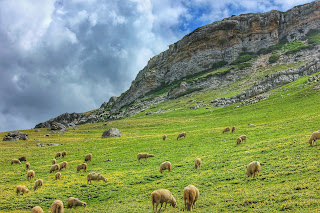On 5th august a historic decision
was taken by Modi government to scrap article 370 of
J&K and further divide it into two union territories namely
J&K and Ladakh. This bold move has changed the entire picture of India’s
Crown.
The story begins from 1947…. India’s independence.
Indian independence divided it into two countries namely India and
Pakistan. Bearing the wound of division, India slowly started
incorporating its distinct regions into one garland. Three states where
unwilling to join India within Indian borders- Hyderabad , Junagarh and
J&K. They were ruled by different rulers who decided to stay out of
chaos. Hyderabad was taken over by police action whereas Junagarh
by plebiscite.
J&K was being ruled by Maharaja Hari Singh, a Hindu
ruler for Muslim majority state. At the time of Independence, the state
of J&K was independent state and so refused to join any faction. But soon
after august 1947, the Pakistan army with pushtoon fighters attacked Kashmir.
In a dilemma, with no options left, Raja asked India for help in return of accession
of Kashmir to India. India send its troops to counter the attack and
the beautiful state was saved. But incorporation was not so simple and easy. Since
the state was at a delicate geopolitical situation and a bone of
contention among India and Pakistan, it had to be taken care off.
Article 370 was incorporated in 1949 under the
“instrument of accession”, signed by Sheikh Abdullah, PM of
Kashmir (appointed by Hari Singh) and Governor General of India Lord
Mountbatten under PM Nehru. It came into force in 1952.
It provided a nearly autonomous status to J&K
and gave only three subjects to Centre mainly defence, foreign
affairs and communication. The other matters of union could apply by president’s
assent only with the concurrence of state assembly. Further article 35A was added by presidential
order to identify citizens of J&K and provide them with certain special
priviIeges. Until 5th august 2019, following was the status of J&K:,
- The state had its own constitution
- People of Kashmir had two citizenship, both of the state and the country
- The state had its own flag
- The state had its own fundamental rights and no fundamental duties for its citizens
- India could declare national emergency only on grounds of external aggression and not on internal disturbance
- No financial emergency could be declared there
- As per article 35A, no Indian citizen belonging to other state could buy a property in J&K or get a government job. Further the provision was stringent over daughters marrying with outsiders (from a different state) as they lost the right to own a property after marriage which additionally deprived their children too.
As of now, according to Jammu and Kashmir Reservation (Second Amendment) Bill, 2019 and the J&K Reorganisation Bill, 2019 article 370 including art 35A turns scrapped. The above provisions will not apply to the
state and it will be governed as other union territories with single
citizenship and only one flag i.e. the National Flag. The UT of J&K will
have state legislature with Chief Minister and Lt. G. as of Union territory of Delhi.
The UT of Ladakh will be without legislature as that of UT of Chandigarh. The
centre has passed this amendment by executive action via President’s signature
and state Governor’s assent as the state is under President’s rule currently.
Some issues have been raised by the critics over the
amendment. Let’s have a look at certain issues and their govt’s response:
- Firstly, Is art 370 a part of basic structure of constitution? And if it is, can the govt change it autonomously? (as per Supreme Courts judgement in Keshavananda Bharti case 1973,the parliament can change the constitution but not basic structure).
- Secondly, the above govt's statement itself raises a question, as to how can the govt abrogate 370 all alone without the concurrence of constituent assembly since the constituent assembly of the state existed only during independence and is now dissolved since then?
In response, the govt’s gazette highlights
that since there is no constituent assembly the legislative assembly will act
as constituent assembly. Moreover, currently the state in under Presidents rule,so the Governor will represent the state and his assent is sufficient on behalf of the
state .
- Thirdly, scrapping article 370 would mean ending the instrument of accession altogether. Will it not lead to an end of Kashmir’s accession to India? This might be a question raised in the Supreme Court in near future.
- Fourthly, there is a fear of neighbouring countries like Pak and China to use this situation as a tool to mobilise people against India and may enhance extremism in the region.
Altogether as every coin has two faces …the
clashes between pros and cons will continue. What is important at this stage,
is the prosperity of the people of Jammu and Kashmir and unity
of our nation. We hope that Kashmir turns into a Peaceful Heaven
of India as it used to be. As I end, let’s recall our very famous
prayer quote from school -
“where the head is held high
And the mind is without fear
into that heaven of freedom my father let my country
awake….”







